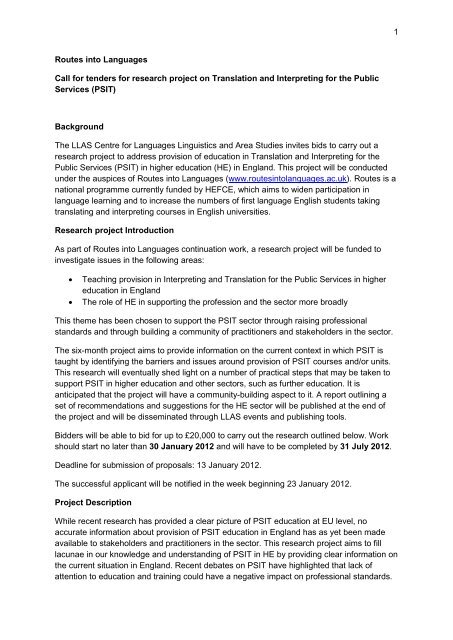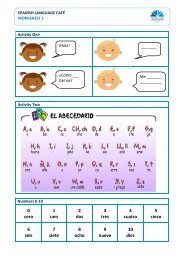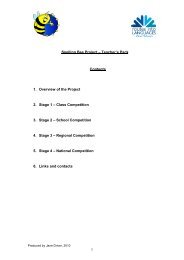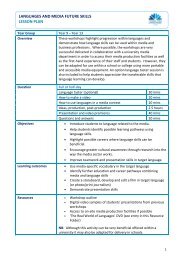For project description and further information please click here
For project description and further information please click here
For project description and further information please click here
Create successful ePaper yourself
Turn your PDF publications into a flip-book with our unique Google optimized e-Paper software.
1Routes into LanguagesCall for tenders for research <strong>project</strong> on Translation <strong>and</strong> Interpreting for the PublicServices (PSIT)BackgroundThe LLAS Centre for Languages Linguistics <strong>and</strong> Area Studies invites bids to carry out aresearch <strong>project</strong> to address provision of education in Translation <strong>and</strong> Interpreting for thePublic Services (PSIT) in higher education (HE) in Engl<strong>and</strong>. This <strong>project</strong> will be conductedunder the auspices of Routes into Languages (www.routesintolanguages.ac.uk). Routes is anational programme currently funded by HEFCE, which aims to widen participation inlanguage learning <strong>and</strong> to increase the numbers of first language English students takingtranslating <strong>and</strong> interpreting courses in English universities.Research <strong>project</strong> IntroductionAs part of Routes into Languages continuation work, a research <strong>project</strong> will be funded toinvestigate issues in the following areas:Teaching provision in Interpreting <strong>and</strong> Translation for the Public Services in hig<strong>here</strong>ducation in Engl<strong>and</strong>The role of HE in supporting the profession <strong>and</strong> the sector more broadlyThis theme has been chosen to support the PSIT sector through raising professionalst<strong>and</strong>ards <strong>and</strong> through building a community of practitioners <strong>and</strong> stakeholders in the sector.The six-month <strong>project</strong> aims to provide <strong>information</strong> on the current context in which PSIT istaught by identifying the barriers <strong>and</strong> issues around provision of PSIT courses <strong>and</strong>/or units.This research will eventually shed light on a number of practical steps that may be taken tosupport PSIT in higher education <strong>and</strong> other sectors, such as <strong>further</strong> education. It isanticipated that the <strong>project</strong> will have a community-building aspect to it. A report outlining aset of recommendations <strong>and</strong> suggestions for the HE sector will be published at the end ofthe <strong>project</strong> <strong>and</strong> will be disseminated through LLAS events <strong>and</strong> publishing tools.Bidders will be able to bid for up to £20,000 to carry out the research outlined below. Workshould start no later than 30 January 2012 <strong>and</strong> will have to be completed by 31 July 2012.Deadline for submission of proposals: 13 January 2012.The successful applicant will be notified in the week beginning 23 January 2012.Project DescriptionWhile recent research has provided a clear picture of PSIT education at EU level, noaccurate <strong>information</strong> about provision of PSIT education in Engl<strong>and</strong> has as yet been madeavailable to stakeholders <strong>and</strong> practitioners in the sector. This research <strong>project</strong> aims to filllacunae in our knowledge <strong>and</strong> underst<strong>and</strong>ing of PSIT in HE by providing clear <strong>information</strong> onthe current situation in Engl<strong>and</strong>. Recent debates on PSIT have highlighted that lack ofattention to education <strong>and</strong> training could have a negative impact on professional st<strong>and</strong>ards.
2However, as it st<strong>and</strong>s, PSIT in HE faces considerable challenges both financially <strong>and</strong> in theprovision of language-specific tuition. In addition, the subsequent income that graduates ofPSIT courses can earn in the public sector is often relatively low <strong>and</strong> careers are insecure. 1The aim of this <strong>project</strong> is to analyse the current l<strong>and</strong>scape of PSIT, to highlight examples ofgood practice <strong>and</strong> to offer some practical recommendations on ways in which the HE sectormay support PSIT in a rather more sustainable way.The <strong>project</strong> is divided into two parts. Part 1 involves data collection <strong>and</strong> analysis in fourthematic areas while Part 2 is practical <strong>and</strong> focuses on the collection of resources <strong>and</strong>examples of good practice <strong>and</strong> community-building activities, as detailed below. <strong>For</strong> bothparts it is desirable to gain an insight into the current situation in PSIT for languages of thewider world (including less widely taught <strong>and</strong> used languages) <strong>and</strong> for British Sign Language(BSL).PART 1a) Research questions1. Analysis of the context What are the barriers, problems <strong>and</strong> issues in the provision of courses in PSIT athigher education level in Engl<strong>and</strong>?This should include an overview of existing reports <strong>and</strong> research relevant to the field of PSIT<strong>and</strong> a list of existing provision. Barriers to provision of teaching in PSIT should then beidentified so that a clear picture of the context can be established.2. Education <strong>and</strong> Pedagogy What are the views of practitioners in PSIT on the practical steps which could beundertaken to improve the viability of PSIT teaching in HE? How can curriculum innovation <strong>and</strong> teaching expertise in languages, cultures <strong>and</strong>conference interpreting in HE contribute to the PSIT curriculum? How can research conducted in PSIT contribute to teaching in the same area?One or two case studies showcasing good practice in either or any of these two areasshould be provided: Curriculum development <strong>and</strong> innovation in PSIT Teaching in PSIT3. Quality Can HE contribute to raising st<strong>and</strong>ards in PSIT provision generally <strong>and</strong> in asustainable way? How might this objective be achieved? Is t<strong>here</strong> scope for HE to provide support for the professional development needs ofPSIT trainers outside HE (e.g. in <strong>further</strong> education <strong>and</strong> in the private sector)?1 Special Interest Group on Translation <strong>and</strong> Interpreting for Public Services, Final report of theSpecialist Interest Group meeting, DG Interpretation, European Commission (9 September 2011); thiscan be accessed at http://www.eulita.eu/sites/default/files/SIGTIPS%20Final%20Report.pdf
3One or two case studies illustrating current good practice in quality in HE should be included.Please note that, case studies for languages of the wider world (including minority languages)<strong>and</strong> BSL are especially welcome.4. Community What practical steps can HE undertake to improve collaborations between employers,professional associations <strong>and</strong> practitioners? What can HE do to support other sectors, e.g. <strong>further</strong> education?PART 2b) Practical steps for building a community of practiceThis section of the <strong>project</strong> will involve collecting typical resources <strong>and</strong> examples of goodpractice which teachers <strong>and</strong> trainers of PSIT will find useful in their teaching <strong>and</strong> learning<strong>and</strong> piloting a collaborative tool as detailed below:1. Develop, pilot <strong>and</strong> evaluate a tool for promoting collaboration <strong>and</strong> networking in PSITon a small scale. This may include blogs; discussion fora; mailing lists; repositories<strong>and</strong> other tools which you think will contribute to the formation of virtual communitiesof professionals, interpreters <strong>and</strong> translators, those working in training centres <strong>and</strong>interpreting <strong>and</strong> translation users. Make recommendations on ways in whichcollaboration <strong>and</strong> networking may be developed <strong>and</strong> enhanced in the future throughuse of technology. A set of practical guidelines <strong>and</strong> evaluation of this tool should beincluded in this section.2. Provide 2/3 examples of good practice for each of the following categories: Audio resources, e.g. examples of telephone interpreting or audio exercises ontelephone interpreting Video-conferencing resources, e.g. examples of video conferences or exercises onvideo-conferencing Lesson plans Self <strong>and</strong> peer evaluation ExaminingMethodologyThis research will involve:Part 1A review of relevant literature on teaching PSIT, on the context of teaching <strong>and</strong>learning PSIT in Engl<strong>and</strong>Telephone interviews with stakeholders <strong>and</strong> with university staffQuestionnaires <strong>and</strong> surveysWeb searches
4Part 2Discussion with stakeholdersWeb searchesDevelopment of collaborative toolsEvaluation of blogs, forums, <strong>and</strong> any other tool usedNote that for Part 2 creative suggestions on how innovative community-building activitiesmight be implemented are welcome.OutputsA research report of approximately 15,000 wordsA set of discrete resources which might encourage collection <strong>and</strong> circulation ofquality teaching materials among PSIT practitionersRecommendations to providers <strong>and</strong> stakeholders in the HE sector on the (potential)practical steps which would need to be undertaken to address problems <strong>and</strong> issuesin the provision of PSIT as indicated in the reportA number of case studies showcasing examples of good practice in PSIT teaching<strong>and</strong> learning <strong>and</strong> of successful community-building activitiesMaterials produced in Part 2 of the <strong>project</strong> <strong>and</strong> related recordsA descriptive bibliography of the literature available on the topicOutcomesA detailed overview of the PSIT sector in HE in Engl<strong>and</strong> including a clearidentification of the problems <strong>and</strong> issues in PSIT provision <strong>and</strong> a number of examplesof good practiceA robust set of recommendations for providers <strong>and</strong> stakeholders in the HE sectorAn indication of the future sustainability of PSIT provisionAvenues for <strong>further</strong> researchConditions of fundingBidders will be expected to:Be able to provide a proven track record of expertise or research in the PSIT sectoror a related fieldHave a background/experience of successful research <strong>and</strong>/or development of<strong>project</strong>s. Some <strong>project</strong> management experience is desirable, but not essential.Be willing to participate in dissemination events <strong>and</strong> other events relevant to the topicthat LLAS or Routes into Languages may organise in the futurePreference will be given to bids w<strong>here</strong> the principal investigator will be substantiallyundertaking the research.Bidders should submit a proposal for up to £20,000 of funding. Funding may coverBuying out staff timeOffice costs
5Travel expensesDevelopment of online toolsContribution to overheads (to be included in the amount bid for)Allocation of funding25% of funding requested will be allocated at the start of the <strong>project</strong> (January 2012). A<strong>further</strong> 25% will be allocated in April 2012 on receipt of satisfactory updates on progress <strong>and</strong>the final 50% will be awarded on receipt of a satisfactory research report.Submitting a proposalProposals should be sent using the official form only. One electronic copy <strong>and</strong> one copysigned by the lead investigator <strong>and</strong> the Head of School/Dean of Faculty or equivalent shouldbe sent to:Dr Angela Gallagher-BrettLLAS Centre for languages, linguistics <strong>and</strong> area studiesFaculty of HumanitiesUniversity of SouthamptonHighfieldSouthamptonSO17 1BJroutes@soton.ac.uk (Please note that all network, email <strong>and</strong> internet access will be downfrom 3 – 6 January 2012, if you require any assistance during this time <strong>please</strong> call 023 80599413)Both the electronic <strong>and</strong> signed copies of the proposal should be received by Monday 9January 2012.
6Application form for research <strong>project</strong>Total Funding soughtName of lead investigatorBrief <strong>description</strong> of current role <strong>and</strong>responsibilities of lead investigatorName(s) of other staff involvedBrief <strong>description</strong> of current role <strong>and</strong>responsibilities of other staffAddressTelephone numberEmail addressBrief <strong>description</strong> of current role <strong>and</strong>responsibilities of lead investigatorProject timetable <strong>and</strong> milestonesPlease describe how you will carry out the research <strong>project</strong> belowFebruary to April 2012May to July 2012
7Funding soughtPlease outline the funding sought in each sectionStaff costsTravel <strong>and</strong> subsistenceOffice costsDevelopment of online toolsPlease give your reasons for applying <strong>and</strong> explain your qualifications, experience <strong>and</strong>existing achievement in this area (no more than 500 words)Please briefly outline any ethical issues that may arise in your <strong>project</strong> <strong>and</strong> how you intend toaddress them.
8I confirm that I will be the lead investigator in this <strong>project</strong> <strong>and</strong> will contribute substantially tothe reportSignature of lead investigator:……………………………………………Name <strong>and</strong> position:…………………………………………………………Institution (if applicable) ……………………………………………………Agreement of senior management of institution(s) involved (if applicable)Signature of Head of School or Dean of Faculty………………………………………………………….Name <strong>and</strong> position………………………………………………………………..
















